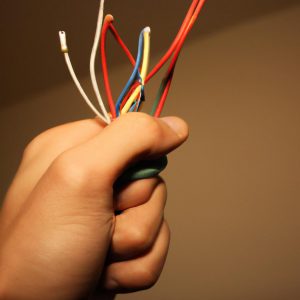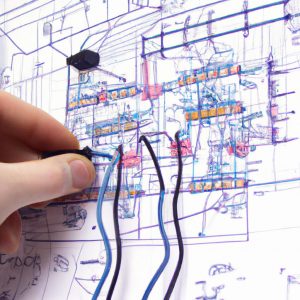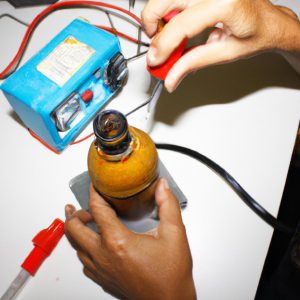Voltage: A Comprehensive Guide to Electricity in Physics

Voltage is a fundamental concept in the study of electricity, playing a vital role in understanding various phenomena and applications. In physics, voltage refers to the potential difference between two points in an electrical circuit or system. This comprehensive guide aims to provide readers with a thorough understanding of voltage and its significance within the realm of electricity.
Imagine a scenario where a homeowner experiences flickering lights whenever certain appliances are turned on simultaneously. By delving into the world of voltage, one can unravel the underlying cause behind these fluctuations. Understanding voltage allows us to comprehend why some devices require higher voltages for optimal functionality while others operate at lower levels. Moreover, comprehending this concept enables engineers and scientists to design efficient circuits that cater to specific voltage requirements, ensuring smooth operation and preventing issues such as power surges or failures.
This article will delve into the basic principles of voltage, exploring how it is measured, calculated, and utilized in practical scenarios. Additionally, it will address related concepts such as current and resistance, highlighting their interplay within electrical systems. Through this comprehensive examination of voltage in physics, readers will gain valuable insights into the intricate workings of electricity and its diverse applications across various fields.
What is Voltage?
Voltage: A Comprehensive Guide to Electricity in Physics
What is Voltage?
Imagine a scenario where you plug an electronic device into a power outlet and it immediately starts functioning. Have you ever wondered what enables this seamless flow of energy from the source to your device? The answer lies in understanding voltage, which plays a crucial role in electrical systems. In simple terms, voltage can be defined as the potential difference between two points in a circuit that allows current to flow.
To comprehend the concept of voltage more comprehensively, let us consider an example. Picture a flashlight powered by batteries. When you turn on the switch, electrons within the battery start moving due to the applied electric field. These charges then move through the wires of the flashlight until they reach the bulb, causing it to emit light. This movement of charged particles is made possible by voltage.
To further grasp the significance of voltage, we can explore its essential characteristics:
- Magnitude: Voltage represents how much potential energy each charge carries and is measured in volts (V). It determines the strength or intensity of an electric field.
- Polarity: Voltage possesses polarity since it involves positive and negative charges. The direction of electron flow depends on whether there is higher potential at one point compared to another.
- Source: Various sources generate voltages such as batteries, generators, solar panels, and even power outlets connected to electrical grids.
- Resistance: Resistance affects voltage since it limits or controls how much current flows through a component or material.
Consider the following table for better visualization:
| Characteristic | Description |
|---|---|
| Magnitude | Determines strength/intensity of electric field |
| Polarity | Depends on relative potential differences |
| Source | Batteries, generators, solar panels, etc. |
| Resistance | Controls current flow |
Understanding these characteristics helps scientists and engineers manipulate electricity effectively while designing circuits or optimizing power usage. By manipulating voltage, they can regulate the behavior of electrical systems to achieve desired outcomes.
As we delve deeper into the realm of electricity, our next step is to explore electric potential and its relationship with voltage. Understanding electric potential will provide a more comprehensive understanding of how voltage functions within electrical systems.
Understanding Electric Potential
As we delve deeper into the intricacies of voltage, it becomes evident that understanding electric potential is crucial. In this section, we will explore the concept of electric potential and its significance in the world of electricity.
To grasp the idea of electric potential, let’s consider a hypothetical scenario. Imagine two points A and B within an electrical circuit connected to a battery. Point A is closer to the positive terminal of the battery, while point B is closer to the negative terminal. The difference in energy per unit charge between these two points is known as electric potential.
Electric potential can be thought of as a measure of how much work must be done on a charged particle to move it from one point to another against an electric field. It depends not only on the distance between two points but also on the presence of any other charges or objects in their vicinity.
To comprehend electric potential more comprehensively, here are four key aspects worth considering:
- Electric Field: Electric potential arises due to the presence of an electric field generated by charged particles.
- Scalar Quantity: Unlike voltage, which has both magnitude and direction, electric potential is a scalar quantity without any specific direction.
- Unit of Measurement: The SI unit for measuring electric potential is volts (V), representing joules per coulomb.
- Reference Point: To calculate absolute values for electric potential at different points, a reference point with zero potential is required.
Now, let us examine these characteristics more systematically through the following table:
| Characteristics | Explanation |
|---|---|
| Electric Field | Generated by charged particles |
| Scalar Quantity | No specific direction |
| Unit of Measurement | Volts (joules per coulomb) |
| Reference Point | Essential for calculating absolute values |
By familiarizing ourselves with these fundamental properties, we establish a solid foundation for comprehending the interplay between voltage and electric potential, which we will explore in detail in the subsequent section.
As we transition to our next topic, it is essential to note that voltage and current are intimately connected. By understanding how these two concepts relate to each other, a clearer picture of electricity’s behavior can be painted. Let us now delve into this intricate relationship without delay.
The Relationship between Voltage and Current
In the previous section, we delved into the intricacies of electric potential and its significance in the realm of physics. Now, let us explore further how voltage relates to current, shedding light on their interconnectedness within electrical circuits.
To illustrate this connection, consider a simple circuit consisting of a battery connected to a resistor. As an electric current flows through the circuit, it encounters resistance offered by the resistor. This interaction between voltage and current is analogous to water flowing through a pipe with varying diameters – the narrower the pipe (higher resistance), the more effort (voltage) required for water (current) to flow through smoothly.
To better comprehend this relationship, let’s examine some key points:
- Voltage: Represented by V and measured in volts (V), voltage refers to the potential difference across two points in an electrical circuit.
- Current: Symbolized as I and quantified in amperes (A), current signifies the rate at which charge flows through a conductor.
- Ohm’s Law: According to Ohm’s Law, there exists a direct correlation between voltage, current, and resistance. It can be expressed mathematically as V = IR, where R denotes resistance.
- Power Dissipation: When electricity passes through a resistor or any other component in a circuit, power is dissipated. The amount of power dissipated can be calculated using P = IV.
Now that we have explored these fundamental concepts surrounding voltage and current, our next section will delve deeper into Ohm’s Law and its impact on understanding electrical circuits. By examining this law alongside voltage relationships, we will gain valuable insights into analyzing complex circuits effectively.
Ohm’s Law illuminates intriguing aspects about electrical phenomena; let us now uncover its mysteries together!
Ohm’s Law and Voltage
In the previous section, we explored the intricate relationship between voltage and current in an electrical circuit. Now, let’s delve deeper into this fascinating connection by examining Ohm’s Law and its implications on voltage.
To illustrate this concept further, consider a hypothetical scenario where we have a simple circuit consisting of a battery (with a voltage source) connected to a resistor. When the circuit is closed, electrons flow through the conductor from the negative terminal of the battery towards the positive terminal. This movement of charge creates an electric current within the circuit.
Ohm’s Law states that there is a direct proportionality between voltage and current when resistance remains constant. In other words, as voltage increases, so does the current flowing through the circuit if resistance remains unchanged. Conversely, if we decrease the voltage supplied by our battery while keeping the resistance constant, the current will correspondingly decrease.
Now let’s explore some key points regarding voltage:
- Voltage measures the potential difference between two points in an electrical circuit.
- The unit for measuring voltage is volts (V), which represents one joule per coulomb.
- A higher voltage indicates greater electrical potential energy available to move charges through a circuit.
- Electrical appliances are designed to operate at specific voltages to ensure their safe and efficient functioning.
Consider this table highlighting common household appliances and their corresponding operating voltages:
| Appliance | Operating Voltage |
|---|---|
| Television | 120 V |
| Refrigerator | 220 V |
| Laptop charger | 19 V |
| Light bulb | 12 V |
Understanding these fundamental principles about voltage paves the way for us to explore how it can be measured accurately using devices called voltage meters. In our next section, “Measuring Voltage: Voltage Meters,” we will examine these tools in detail.
Remembering that proper understanding of voltage is essential in comprehending the intricacies of electricity, we can now transition seamlessly into our exploration of voltage meters and their role in electrical measurements.
Measuring Voltage: Voltage Meters
Building upon the principles of Ohm’s Law and how voltage is defined, we now delve into the practical aspect of measuring voltage. Understanding how to accurately measure voltage is crucial in various fields, from electrical engineering to household repairs. In this section, we will explore different methods and devices used for measuring voltage.
Imagine you are an electrician tasked with troubleshooting a faulty circuit in a residential building. You suspect that there might be irregularities in the voltage levels across certain components. To confirm your suspicions, you decide to use a digital multimeter (DMM) – one of the most commonly used tools for measuring voltage.
Using a DMM allows you to obtain accurate readings by connecting its probes across the component or circuit being tested. It then displays the measured value on a digital screen. However, it’s important to note that different types of circuits require different measurement techniques and settings on the DMM.
To effectively measure voltage using a DMM, consider the following:
- Ensure proper connection: Connect the red probe to the positive terminal and black probe to the negative terminal.
- Select appropriate range: Set your DMM’s range selector switch according to the expected voltage level. This prevents overloading or misreading due to exceeding device limits.
- Observe polarity: Pay attention to polarity when measuring DC voltages; incorrect connections can lead to inaccurate readings.
- Safety precautions: Always prioritize safety by wearing insulated gloves and ensuring that no exposed wires or live parts pose any risk during measurements.
| Measurement Method | Advantages | Disadvantages |
|---|---|---|
| Digital Multimeters | Accurate and precise measurements | Limited frequency response |
| Oscilloscopes | Provides visual representation of waves | Complex setup requiring technical expertise |
| Clamp Meters | Non-invasive measurements | Only measures AC currents |
| Voltage Testers | Quick and easy to use | Less accurate compared to other measurement methods |
Understanding how voltage can be measured effectively sets the foundation for its applications in various circuits. In the subsequent section, we will explore practical examples that highlight the significance of voltage in everyday electronic devices.
[Next section H2: Applications of Voltage in Circuits]
Applications of Voltage in Circuits
Having discussed the concept of voltage in the previous section, let us now explore how voltage can be measured using voltage meters. One example of a commonly used voltage meter is the digital multimeter (DMM). This versatile instrument allows for precise measurements of various electrical quantities including voltage. By connecting the leads of the DMM to different points in an electrical circuit, one can determine the potential difference between those points.
To better understand the importance and practical applications of measuring voltage, consider the following case study: Imagine a household with multiple appliances connected to a power source. If one appliance suddenly stops working, there could be several reasons behind this issue. Using a voltage meter, it becomes possible to identify whether there is a problem with the incoming supply or if the fault lies within that particular appliance itself. This knowledge enables targeted troubleshooting and efficient repair.
When using a voltage meter, keep in mind these key considerations:
- Ensure proper calibration and accuracy before taking any measurements.
- Take precautions such as wearing appropriate safety gear when dealing with high voltages.
- Follow manufacturer instructions for correct usage and handling of your specific type of voltage meter.
- Understand that different types of circuits may require specialized techniques or equipment for accurate measurements.
The table below summarizes some common types of voltage meters along with their respective features:
| Type | Features |
|---|---|
| Digital | High resolution |
| Analog | Real-time response |
| Clamp | Non-intrusive measurement |
| Oscilloscope | Ability to visualize waveforms |
In conclusion, understanding how to measure voltage is crucial for diagnosing electrical problems and ensuring safe operation of devices and systems. With various types of voltage meters available, each offering unique advantages, selecting the right tool depends on factors such as precision requirements and specific application needs. Remembering important considerations while utilizing these instruments will enhance accuracy and minimize risks associated with electrical measurements.








